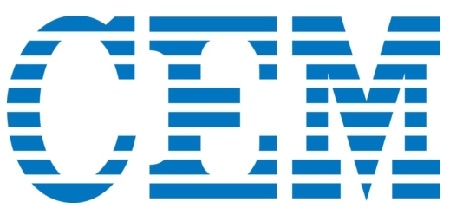The epidermal growth factor receptor variant III (EGFRvIII) is a constant and tumor-specific mutation found in several types of cancer. This makes EGFRvIII an attractive target for antitumor immunotherapy. An EGFRvIII-targeted peptide conjugated to keyhole limpet hemocyanin has been recognized as a tumor-specific vaccine. Slow Fmoc deprotection rates have been shown to affect the EGFRvIII peptide synthesis, resulting in reduced peptide purity. This article discusses the effect of microwave technology on the EGFRvIII peptide synthesis, focusing the application of microwave irradiation for each step of the synthesis.
Reagents
Peptides International provided all Fmoc amino acids and PCAS Biomatrix supplied Rink Amide Chem-Matrix resin. EMD Chemicals offered OxymaPure and N,N-dimethylformamide (DMF), while Sigma Aldrich provided triisopropylsilane (TIS), trifluoroacetic acid (TFA), piperidine, W,W-Diisopropylcarbodiimide (DIC), and 3,6-dioxa-1,8-octanedithiol (DODT), and VWR supplied acetonitrile, HPLC grade water, acetic acid, anhydrous diethyl ether, and dichloromethane (DCM).
Peptide Synthesis - LEEKKGNYVVTDHC-NH2
The CEM Liberty automated microwave peptide synthesizer was used to prepare the peptide on Rink Amide Chem-Matrix resin (0.52mmol/g). Microwave deprotection was conducted with 20% piperidine in DMF in two stages with an initial deprotection of 30s and subsequent deprotection for 3min 75°C. Traditional deprotection was conducted with the same reagents in two stages with an initial deprotection of 5min followed by 10min at 21°C.
The deprotection of Leu involved an initial deprotection of 30s followed by two cycles of 3min at 75°C. Conventional deprotection of Leu required 5min of initial deprotection followed by two cycles of 10min at 21°C. Microwave coupling reactions were conducted with a five-fold excess of Fmoc-AA-OH with 1:1:1 AA/DIC/Oxyma for 5min at 75°C. Traditional couplings were done with the same reagents for 30min at 21°C. However, the coupling of Leu needed double coupling for 5min each at 75°C, and for conventional, 30min each at 21°C. Four syntheses of EGFRvIII carried out utilizing the conditions summarized in Table 1.
Table 1. Synthesis Conditions and Results for the Preparation of EGFRvIII
| Entry |
Deprotection |
Coupling |
Synthesis Time |
Crude Purity |
| 1 |
Conv |
Conv |
18 h 40 min |
18% |
| 2 |
Conv |
MW |
11 h 40 min |
25% |
| 3 |
MW |
Conv |
14 h 57 min |
39% |
| 4 |
MW |
MW |
8 h 44 min |
61% |
Conv = conventional, MW = microwave
Cleavage of the finished peptide was done for 30min utilizing 92.5:2.5:2.5:2.5 TFA/H2O/TIS/DODT at 38°C, followed by precipitation and washing of the peptide in diethyl ether.
Peptide Analysis and Results
The peptide analysis was performed in a Waters Symmetry300 C4 Column (5µm, 2.1 x 150mm) at 214nm with a gradient of 5 - 95% MeCN with 0.1% formic acid, 0 - 25 min, with the column heated to 40°C. Mass analysis was conducted using an LCQ Advantage ion trap mass spectrometer equipped with electrospray ionization (Thermo Electron).
The first synthesis of EGFRvIII was done with both the coupling and deprotection reactions all at room temperature utilizing traditional conditions (Table 1, Entry 1). It took roughly 19hr to complete the reaction to yield only 18% crude purity. Deletions of the N-terminal Leu and incomplete removal of the final Fmoc are the key products from this synthesis (Figure 1).
.jpg)
Figure 1. LC chromatograms for the synthesis of EGFRvIII under a range of conditions. (RT = room temperature, MW = microwave)
To study the influence of microwave irradiation on EGFRvIII synthesis, the coupling reaction was performed under the application of microwave energy, while the deprotection was still carried out under conventional conditions. The synthesis time was shortened by over 35%, but crude purity of the peptide slightly improved to 25% with the application of microwave energy for the coupling reaction. This synthesis showed a slight decrease in synthesis time, but with over 20% to 39% improved crude purity.
Finally, the synthesis was carried out by applying the microwave energy for both the coupling and the deprotection reactions (Entry 4). The crude purity was improved to 61% and the synthesis time shortened to less than half that of the conventional technique.
Conclusion
The EGFRvIII synthesis was carried out under both microwave and conventional conditions, yielding a range of crude purities and synthesis times based on the conditions applied. The optimal results were obtained by applying microwave irradiation to perform both the coupling and deprotection reactions. Although the microwave technology is advantageous to both the coupling and deprotection reactions, the stepwise approach to the synthesis optimization showed that the use of microwave irradiation had a more significant impact on the deprotection reaction than the coupling reaction.

This information has been sourced, reviewed and adapted from materials provided by CEM - Analytical
For more information on this source, please visit CEM - Analytical.